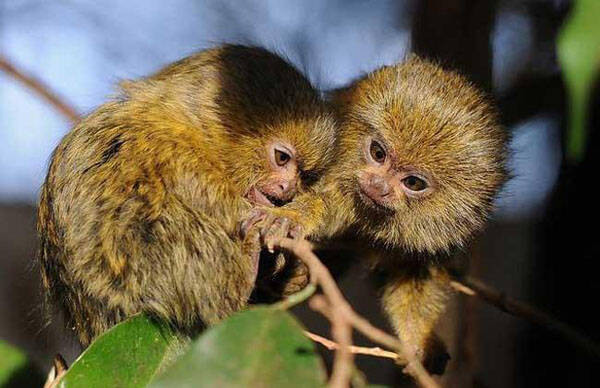Cebuella pygmaea
IUCN
LCBasic Information
Scientific classification
- name:Cebuella pygmaea
- Scientific Name:Cebuella pygmaea,Pygmy Marmoset,Pygmy marmoset, squirrel monkey, bird monkey
- Outline:Primates
- Family:Marmoset P.Marmoset
Vital signs
- length:About 12 cm
- Weight:107-141g
- lifetime:10-12years
Feature
The smallest primate in South America
Distribution and Habitat
Distributed in Bolivia, Brazil (Acre, Amazon, Rondônia), Colombia (Colombia (mainland)), Ecuador, Peru.
Appearance
When a pygmy marmoset grows up, it is only a little over 12cm tall, 117-152mm long, 172-229mm long tail, and weighs 107-141g, about 60g on average, which is not even as big as a squirrel. It is the smallest primate in South America. It has an elongated face, long hair on its cheeks, and short ears. Its body hair is gray-brown, with spots on its back that are formed by light and dark colors. The fur on the buttocks of adult males is whiter than that of females. The pygmy marmoset is not only the smallest monkey in the world, but also the smallest primate. Although the pygmy marmoset is small, its tail is very long, usually more than 20cm long, and acts as the fifth limb when moving, and can wrap around tree trunks and branches, adapting to life in the forest.
Details
The scientific name of the pygmy marmoset is Cebuella pygmaea, and its foreign name is Pygmy Marmoset. There are two subspecies. It is a small monkey that lives in the tropical rainforests of South America and looks and behaves like a squirrel.

The pygmy marmoset likes to live in the higher parts of the forest canopy. They live in small groups of 3-10 individuals each, and each group has a certain range of activities. They are mostly active in the morning and afternoon. The pygmy marmoset is extremely agile, and when its safety is threatened, it can quickly rush along the branches to hide in a hidden place. It is an omnivorous animal, feeding on tree sap, buds, fresh fruits, insects, spiders and lizards. When eating sap, it first bites through the bark with its lower canine teeth to draw out the sap. In addition to eating plants, pygmy marmosets also catch moths, flies, spiders, grubs, etc. The pygmy marmoset is a lower monkey, and its insectivorous habit is a reversion to ancestral inheritance because its ancestors were insectivorous animals.
The pygmy marmoset has no fixed breeding period, with a gestation period of 4-5 months and 1-2 cubs per litter. Newborn cubs weigh about 18 grams, and their fur is darker than that of adults. A few hours after birth, the father also helps the mother take care of the cubs, sometimes carrying them on his back. After about two weeks, they can leave their parents for a short period of time. They can move around regularly after one month, and basically live independently after 4-5 months. They are sexually mature at 13-15 months. The life span is 10-12 years. They basically spend their lives in trees.
Listed in the "World Conservation Union" (IUCN) ver.: 2008 Red List of Primates - Low Risk (LC).
Protect wild animals and eliminate game.
Maintaining ecological balance is everyone's responsibility!








